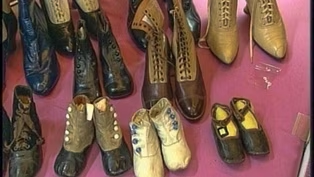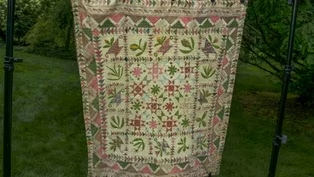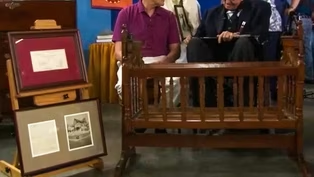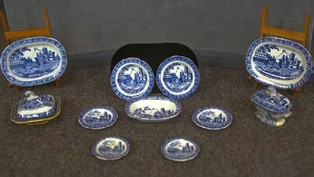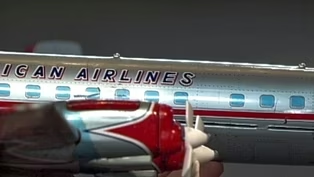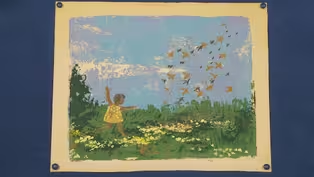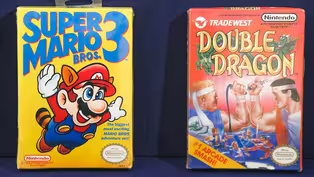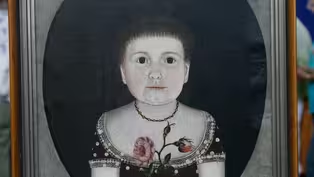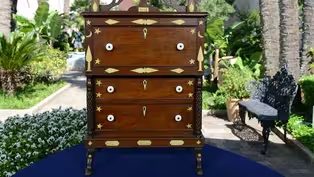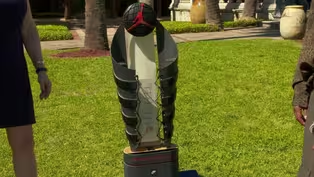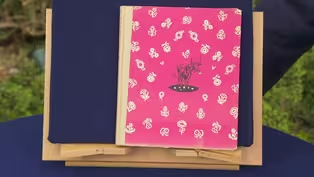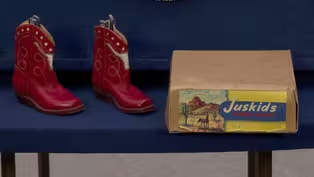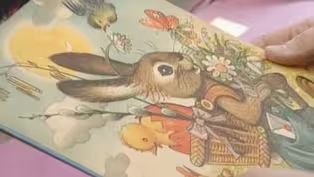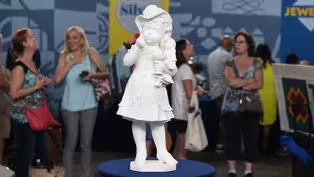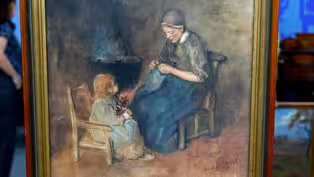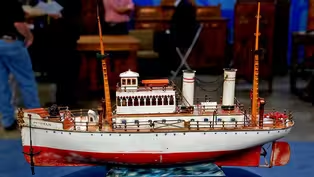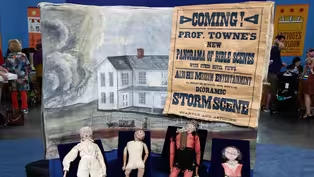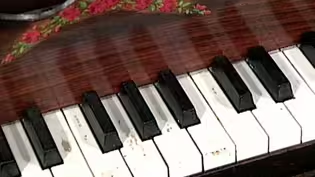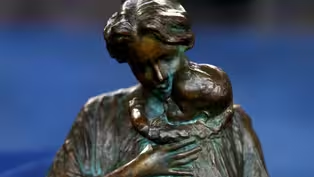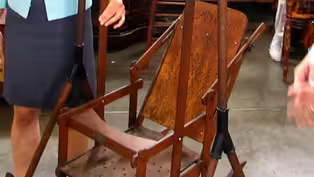
Kids Stuff
Season 29 Episode 23 | 52m 27sVideo has Closed Captions
Take a trip down memory lane for playful ROADSHOW finds that bring out the child in us!
Take a trip down memory lane for playful ROADSHOW finds that bring out the child in us, including a traveling puppet show, ca. 1870, Yakama toy cradle & doll, ca. 1890 and a 1993 Air Jordan sneaker display. One family treasure is $40K-$60K!
Problems playing video? | Closed Captioning Feedback
Problems playing video? | Closed Captioning Feedback
Funding for ANTIQUES ROADSHOW is provided by Ancestry and American Cruise Lines. Additional funding is provided by public television viewers.

Kids Stuff
Season 29 Episode 23 | 52m 27sVideo has Closed Captions
Take a trip down memory lane for playful ROADSHOW finds that bring out the child in us, including a traveling puppet show, ca. 1870, Yakama toy cradle & doll, ca. 1890 and a 1993 Air Jordan sneaker display. One family treasure is $40K-$60K!
Problems playing video? | Closed Captioning Feedback
How to Watch Antiques Roadshow
Antiques Roadshow is available to stream on pbs.org and the free PBS App, available on iPhone, Apple TV, Android TV, Android smartphones, Amazon Fire TV, Amazon Fire Tablet, Roku, Samsung Smart TV, and Vizio.
Buy Now
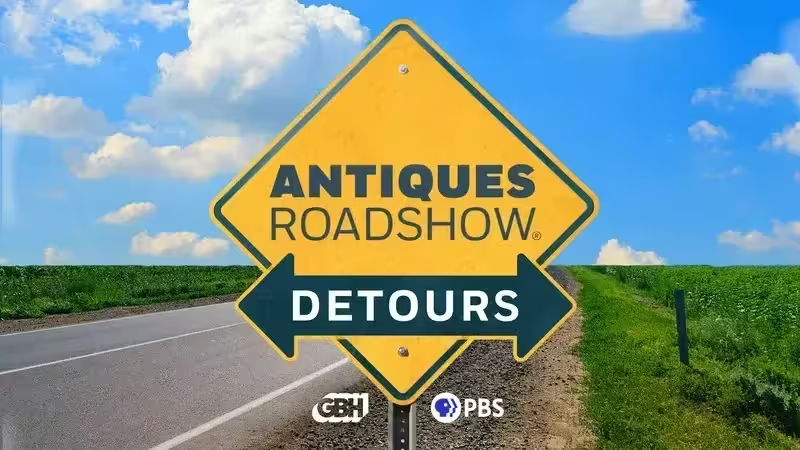
ANTIQUES ROADSHOW DETOURS
Ever wondered what happens to the treasures featured on America’s beloved ANTIQUES ROADSHOW after the cameras leave town? Host Adam Monahan tracks down the juicy afterlives of your favorite finds from PBS’s hit series.Providing Support for PBS.org
Learn Moreabout PBS online sponsorship♪ ♪ CORAL PEÑA: It's playtime at "Antiques Roadshow."
You can see, this is not a one-trick pony.
(laughs) This is a two-trick pony.
That's surprising.
PEÑA: Childhood treasures are getting all the attention in "Antiques Roadshow: Kids Stuff."
♪ ♪ PEÑA: Nostalgia is a great motivation to collectors, especially when it comes to childhood memories of play, imagination, and entertainment.
GUEST: My mother dressed me up.
I know I wore it more than once.
PEÑA: In this special episode, we've got treasures for collectors of all ages who appreciate the fun... Shall we see it play?
Sure.
We drop the coin in here, and there goes Big Bronco.
PEÑA: The practical... The cool thing about it is it's a child size.
PEÑA: ...and the art that captures the innocence of youth.
GUEST: These are two games for a Nintendo gaming system, and my dad gave these to me.
They were two games from the 1980s, and... somebody gave them to him, and he already had the games, so he didn't open them.
And they were just lying for a really long time in my grandma's attic.
First off, bunch of bonus points, kudos to you, 'cause you know what's going on.
You are right in that Nintendo was a 1980s video game system.
The Nintendo Entertainment System, abbreviated by collectors today as simply N.E.S., revolutionized video games when it was first introduced in 1983.
And prior to that, everybody was growing up with Atari, ColecoVision, Intellivision; very, very basic.
You have some of the most iconic games for the N.E.S.
I mean your first one right here, "Super Mario Bros.
3."
I wouldn't be exaggerating if that as a kid with my older brother, we played over 30 hours on that game.
(laughs) Now, also here, we have "Double Dragon."
Totally awesome, bad to the bone, karate fighting style game.
And the thing that's really funny is, in terms of a market, if you came to "Antiques Roadshow" five years ago, we wouldn't be here today.
(laughing) I love that face.
The collectible video game market really exploded 2019 into 2020.
We've seen some very big numbers, uh, very volatile numbers.
So the market is a little unsteady.
When looking at the "Super Mario Bros.
3," we know that it's a second printing instead of a first printing due to the location of the "Bros."
in the title.
A true first printing of the cartridge would have the "Bros" all the way to the left under the M in Mario.
So just that little difference is a big deal in value.
When looking at the "Double Dragon" cartridge, the way we know that it's a second printing of the game is that when we look at the OSQ on the bottom, which is the Official Seal of Quality for Nintendo, on the very first print, this would be a circular form sticker.
The fact that we have the ovoid form sticker knows that this is in fact a second printing of the game.
Now, do you have any idea of what these are worth today?
I don't know, about $100?
In their ungraded, just factory-sealed condition... Yes.
Conservatively, at auction today, the "Super Mario Bros.
3" would be $1,000 to $2,000.
(laughing): Oh, my God.
That's a lot.
Okay, now this is where you're really gonna thank your dad.
The "Double Dragon."
This is easily a $2,000 to $3,000 game.
(laughing): Wow, that's a lot.
So, total at auction today for the pair of cartridges, you would be at $3,000 to $5,000 in the market.
(whispering): Oh my gosh.
That's surprising.
Thank you, Dad?
(laughing): Thank you, Dad.
Graded perfect 9.8 examples of "Super Mario Bros.
3" for the first print have brought upwards of $150,000.
Wow.
This was a gift from my aunt for my first Christmas the following summer of 1950.
My mother dressed me up-- I know I wore it more than once-- and actually took a picture of me, in our neighbor's yard, of me wearing the outfit.
And when I outgrew it, she boxed it up, put it away in the cedar chest, and when she cleaned out her cedar chest, I got it, because, obviously, I've not worn it since.
Well, it's in amazing condition.
I love the red Tom Mix boots.
And look at the wonderful label in the vest, which is Westerner, and it's totally complete with its corduroy skirt just trimmed in fringe.
And, of course, the box is just phenomenal, the advertising still in perfect condition.
Western stuff was, for a while, quite collectible in the '70s and '80s and '90s, and it took a dip for a while, but children's Western things are still collectible.
I would give a value of this, at a good retail shop, from $200 to $300 for the complete ensemble, with the box and with the picture.
Well, it's worth a lot more to me.
It's just a good memory.
You can't pay for sentimental.
No, not at all.
No.
Everything would be a million dollars if that was the case.
Hi, guys.
Thanks an awful lot for bringing your airplane into the "Roadshow" today.
You're welcome.
After the war, the Japanese developed a very nice toy industry, and, uh, they made an awful lot of battery toys, which is what your plane is, uh, powered by.
So, uh, you've tried it out.
How's-- does it run okay?
It runs perfect.
It was your dad's?
It was my dad's, when he was a little boy.
Okay.
Well, he took pretty good care of it.
Let's take a look here, uh... I wanted to show you where the company name was.
That stands for a toy company.
The name was Yone-- Y-O-N-E.
But these are called tin toys.
And battery-operated, like I said.
And your airplane does all kinds of stuff... so it's... Yeah.
...it's actually got three batteries in here.
Three batteries, right.
So, your typical airplane would be probably half the size of this, uh, much less in the way of detailing.
Those kind of airplanes from the same time period, oh, probably'd be $50 to $100.
But you've got the super duper model, which does all kind of things, which we're gonna see in a second.
So really, this airplane's about a $300 airplane today, in real nice shape.
Wow.
All right, well, why don't we see what this does?
Turn on the switch.
Yeah, see what-- see what it does there, William.
(plane whirring) Here goes the stewardess.
All right, ready for takeoff.
(whirring) Closing the door.
Closing the door.
Here go our lights, there go our propellers.
(whirring) It's going the wrong way.
GUEST 2: Yeah... There they go, all four of them.
GUEST 1: All four of them are going.
(whirring) And it starts to move... Okay, there we go.
Goes even faster, probably, if it wouldn't be on the rug.
(whirring) It's one of the first ever made, and we got it as a gift from some of our family members.
My brother, he just kind of keeps it on his shelves in his room.
So we-- I've been collecting them for almost my whole life, So I have at least like 15 or so.
GUEST: This belonged to my grandmother as a baby.
APPRAISER: This was a very early version of the bouncy seat.
It's made by a company called the Glascock Company.
They do show up at auction every now and then as sort of a curiosity.
And I would think you could expect it to fetch probably at $500 if you were in an auction scenario.
Vaguely medieval-looking.
I mean, now Child Protective Services would be called, I think, if your child was in it.
(laughing): Exactly.
(both laugh) GUEST: This was my mother's violin.
And she started playing violin when she was 18 months old.
Her father was a violin instructor in Canton, Ohio.
And this is her first violin, which is a 1/16 size violin.
It's very typical of the French period, about 1860, 1870.
You can tell that it's been very well-respected over the years.
It's in amazingly good condition.
Because it's so old and so rare, in a retail setting, I would say that this violin has a value of $1,500 to $2,000.
That is wonderful, but, you know it'll stay in the family.
GUEST: It was given as a gift to my father's brother for his ninth birthday in 1914.
There was, uh, quite a difference in age-- ten years between my father and his brother.
My dad was the baby, and the two of them had great memories of playing with this boat as they grew up in the Chicago area.
APPRAISER: Now you used it in-- actually in the water?
I have great memories of this floating in my swimming pool in the backyard when I was growing up.
I love toys that come in with stories from the original owners.
It-it really adds to the luster of the item.
Did you figure out who made this?
I know there's a mark on the rudder, but my magnifying glass at home was not strong enough to read it, and I know that it was a gift from a great uncle.
And I... thought he was-- lived in Europe at the time.
If you look real carefully-- and I can recognize this without a magnifying glass because I've seen it a few times-- It actually says "G.M."...
Mm-hmm.
Which means "Gebrüder Märklin."
Okay.
So Märklin is the manufacturer of this boat, which is a German company.
Mm-hmm.
They first went into business in 1859.
Uh, originally, they just made dollhouse and dollhouse furnitures and things like that.
But they really came into their own right after 1900.
Around 1904, they started making trains and boats.
That was when they became the gold standard of toys of their day.
Okay.
They were very expensive in their day, and they're, uh, relatively expensive today.
This is a tin boat.
It has a clockwork motor, which operates this propeller.
Mm-hmm.
And it's beautifully outfitted with a chain.
It had lifeboats, which you say you lost, but they can be made.
And you see, it's named the Puritan.
The Puritan was a very famous boat.
Okay.
The Puritan was on the Fall River Line, which went from Boston to New York City from around 1889 to around 1908.
It was such a famous boat, it was used in a lot of toys.
There are cast-iron American Puritan boats, There are McLoughlin lithograph puzzle boats.
There are several other using that name.
They made a few changes-- the original boat had a side wheel.
This is... probably made 1908, 1910, somewhere in there.
Mm-hmm.
The last one of these I know at auction had an auction estimate of $12,000.
Wow.
Which is quite a sum.
Amazing.
But it sold for $20,000.
All right.
(laughs) And there's no reason this one couldn't do the same.
My goodness.
My goodness.
So don't put it in the water anymore.
I promise I won't.
And it hasn't been in the water for over 50 years.
This piece here was given to me by my best friend and his brother.
When their parents passed away, they knew I always had liked it, and so they asked me if I would like it.
They said it belonged in my house.
I think they paid $1,500 for it.
They didn't know anything about it.
So in my attempt to find out, I took a, uh, paper with a charcoal carbon, so I could make out the signature and the name at the bottom, and then found out it was done by Del Panta in the 1800s.
I just love her.
The little doll dressed in the same outfit she is, the-the wrinkles in her stocking and that... It's a beautiful piece.
You know, it really is a beautiful piece, and, uh, one of the things that really got our attention right away was where the artist signed it.
So right at the little girl's feet it almost looks like there's a calling card that has fallen to the ground.
Exactly.
It also says "Firenze," which is Florence.
Uh-huh.
And it's dated.
Most likely made of Carrara marble.
Okay.
Which was sort of the finest quality marble.
And during this timeframe, in Florence and in Rome, you had artists' studios who were working on these wonderful marble figures.
And it's interesting, some artists at the end of the 19th century considered it inferior to actually touch the work.
(chuckling): Oh, wow.
So, in some cases, the artist's hands never touched the sculpture, and it was a workshop of highly skilled artisans and craftsmen who were making these.
She is wearing this beautiful feathered hat, and so is the little baby girl as well.
The title is "Colazione," which is Italian for "breakfast."
Oh, okay.
So she's here, she's having breakfast, she's got her favorite doll dressed in the same outfit.
It really is absolutely beautiful.
Oh, thank you.
Uh, the detail of the craftsmanship is really wonderful.
The hands-- also the hands of the doll.
Moving down the feet, uh, as well as her feet, the whole thing.
Yes.
The buttons and the ruffles in her dress.
And even at the base with the scrolling and the foliate scrolls.
It's just really wonderful.
One thing that I wanted to point out to you is I'm sure you can see that there's almost this sort of what we call a sugary or a crystalline surface to it.
Yeah.
That's indicative of having it cleaned and maybe just a little bit overcleaned.
Okay.
You want mu-- a much smoother, warmer surface to it.
Okay.
But still, that's a minor issue.
I'll give it a quick spin... Okay.
...so we can just see the quality goes all the way around.
Even on the back of, uh, her dress, it's just wonderful.
And the way that her hair falls.
And the-the lace of the petticoat, I mean, it looks like real lace.
Oh, it's absolutely beautiful.
It's amazing, yeah.
What's interesting is the artist is sort of secondary to the quality of the piece.
We know it was made in Florence in a wonderful workshop, but it's really the quality of the, the subject matter, and the carving, and the size, she's wonderful.
If I were to see this come up for auction today, I believe it would sell for between $12,000 and $18,000.
Oh really, okay.
Wow, that's great.
She's a pretty girl.
Very happy, very well-pleased.
For insurance purposes, you're probably looking closer to $25,000.
Okay, all right.
Wow.
(laughs) APPRAISER: You've brought in this wonderful Air Jordan sneakers display.
Where did you get this?
My grandmother gave it to me.
Ah, all right, Grandma.
Where did you get it?
Well, when my kids were small, when they were babies, I took them to one shoe store.
And years later, the shoe company, uh, store went out of business, and they were throwing away a lot of stuff.
And this was one of the things that I thought was great and not to be thrown away.
So, I got this.
How much did you pay for this?
I didn't have to pay anything for it.
I just kind of saved its life 'cause I thought it was pretty cool.
So, what year was that?
That was probably about eight years ago.
Okay, so why did you think about this as a gift for Miles?
So, his mother played basketball.
Ah.
She was four-year scholarship, basketball college.
Uh, his uncle, my son... Right.
...was a basketball star in high school, and now he's a basketball star.
And I thought this would be great to put up in his room.
How old are you?
Seven.
Okay.
And how long been playing basketball?
About since I was... five.
Okay, so a couple of years.
And your mom taught you.
So, what-what did your mom teach you?
She taught me how to dribble, shoot... and pass.
Dribble, shoot, and pass-- that's all you gotta do.
What do you know about Michael Jordan?
I know he's a good player.
(chuckles) There you go.
Well, Michael Jordan was not just a good player.
Michael Jordan is one of the greatest players of all time.
And he came out of the University of North Carolina, led the Chicago Bulls to six NBA championships.
Michael Jordan signed a deal with Nike for $2.5 million, which was a ton of money in 1984-- it was five-year deal-- and they started making shoes for him.
And all of a sudden, overnight, they became famous as he became famous.
So, you got this great display.
This display is from 1993.
How do I know that?
Well, that was the year of Air Jordan 9.
They decide to take words that were most associated with Michael Jordan.
So here are the words here in English-- "Skill, creative, sport, grace..." Wow.
"...freedom, intense, power, and dedication."
Because they were expanding globally, they put them in all different languages, whether it was Japanese and German and Spanish and Italian.
And those are on the soles of the shoes.
So every year, they would do something like that.
And that's what they did in 1993.
So the shoe would go here.
What do you think, Miles, something like this would be worth?
Hmm, about... $500.
If I was going to put an auction estimate on this, I would put about $500 to $700 on it.
Wow.
It's a pretty cool gift.
That's really good.
GUEST: About three years ago, I went to an es-estate sale and I found those in the attic, and I purchased them for a dollar apiece.
Dollar apiece.
Right, when you came in, I thought these were some kind of big postcards or something.
I didn't even realize they in fact were books.
But not only are they books, we've got Ricky the Rabbit.
We open them up, and what we get is an incredible pop-up book.
Most of these are from the late 19th, early 20th century, and you have some rare ones, like these baby shoes with the cobalt beads.
Just a few years ago, these were about $65, and now they're up somewhere around $130.
GUEST: Wow.
GUEST: Well, it... I got it at a... garage sale when we were all going to garage sales because it was the Warm Springs annual garage sale, and I got it for ten dollars.
GUEST: I found them at a thrift store, and I was actually looking for a present for my wife, and I came across these, and I said, "Whoa, these will make a nice present for her."
You know who the artist is?
They're signed, so that's pretty clear.
It's Bessie Potter Vonnoh, and she was one of America's leading sculptors.
She was born in the 19th century and lived till the middle of the 20th century.
And most of her work was done 1900 till the 1930s.
And what she was known for were these domestic or everyday types of scenes.
Mother and child and this lovely crawling baby.
Made around 1910.
Most sculpture that we see is of famous people: presidents, George Washington, Abraham Lincoln.
And it's very unusual to have sculptors whose subject matter is women and children.
And they're beautifully made, they're very finely detailed.
And what's so nice is the expression that she captures between the, the mother and the child.
And this little baby who's crawling; it's really quite wonderful.
Bessie Potter Vonnoh worked in New York City and she also had a summer house in Connecticut.
And she was married to an American painter named Robert Vonnoh.
He was an Impressionist painter and they worked together.
And actually she's... more famous than he is.
Her work is so popular because of the subject matter that there are a lot of fakes.
Oh, okay.
And what people have done over the years is they'll make a mold of the original and they'll make another casting.
And that's called a surmoulage.
They weren't done during the artist's lifetime, they weren't done under her authorization.
They were done much later.
And it's unfortunate, because it actually keeps a lot of collectors away from collecting sculpture because of this issue with recasts.
What's nice about yours is that they are original.
Oh, really?
If these were surmoulages or recasts, as they're sometimes called, they really wouldn't be worth much.
But these two examples are quite, quite interesting.
What did you say you paid for these?
I paid $20 apiece.
$40 in both of them?
Yes, yes, $40.
Well, this one, the mother and child, recently sold at auction for $4,500.
Wow, that's great.
So an auction estimate on this would be between $4,000 and $6,000.
Okay.
But I have to tell you that about ten years ago, this same model in auction brought $24,000.
Oh, okay.
Wow, what a difference.
It's a big difference.
And that's indicative of what the market can be like.
Sometimes when there's a high price, more pieces come out.
Somebody says, "Hey, I have one of those.
If it's worth that amount, I'm gonna sell it."
So then more come to the market, the price goes down.
This is a lovely little piece also.
At auction, we'd probably put an estimate of between $5,000 and $7,000.
Wow.
A little bit more than the other one, huh?
Yeah, yeah, this is-- this is a bit rarer.
This, uh, this model.
Oh, okay.
GUEST: In probably around 1980, my mother gave it to me.
APPRAISER: Okay.
And she had been given it to her by her grandfather, my great-grandfather, so... Uh, that was in the 1940s.
Had there been talk in the family that somebody in the family had made it?
Yes.
The great-gran-- we always thought the great-grandfather made it.
But doing research, I found out that he was born in 1868, and if this was in 1881, then he could have only been 13.
So we feel like that it was probably his father that made it.
If-- that's, we, we're not sure, we... That's one reason we're here is to find out if it really is handmade.
It is very handmade.
Oh, okay.
It's made out of walnut.
It's got this great scallop backsplash with a shell on the top.
And then all these inlays in bone, they just make it dance in front of your eyes.
We look at the inlay and we think: This has pizzazz.
In 1881, in Iowa, they would have been, what, in farm country?
Yes.
My great-great-grandfather was a farmer.
Okay.
I'm just supposing here-- you'd have to do a DNA test to be positive, but it takes a big, flat piece of bone to make inlays like that, and my guess is they probably used cow bones.
Cow bone.
Because they would have been... Plentiful.
They would have had a herd.
The brown of the walnut wood doesn't overpower the inlay at all.
The inlay is very powerful.
And it looks to be all original.
The pulls are original.
Those are porcelain Victorian-era pulls that have a metal screw going through them, an iron screw.
They were probably machine-made.
And the date of this, obviously, is 1881.
Mm-hmm.
And the cool thing about it is, it's a child size.
Mm.
You know, some people mistakenly refer to these as miniatures, but a miniature would be, like, this tall.
Okay.
This is a presentation piece made, I would say, for a child, probably for somebody very special in the family.
And you guys have obviously treasured it.
Mm-hmm.
Because of the condition.
You know what amazes me the most?
First of all, the feet aren't broken off.
Second of all, it's never been refinished.
Nope, never has.
It has what I call "honest wear."
It has places where it's got some abrasions.
I mean, if you're almost 140 years old, you're going to have a few dents and scratches.
But to a collector, that's perfect.
We felt like, in a good retail setting, that this would sell for about $6,000.
Oh, I wasn't expecting that, but... (laughs) That's good.
Well, what were you expecting?
(chuckles) Maybe $500?
This is a very powerful folk art object.
It's a great piece of American folk art.
Well, thank you very much.
GUEST: I know he's very old.
I think he's around 1910.
I know that he came from Germany and he was my dad's doll.
And I know my dad, unfortunately, gave him a haircut... (chuckles) ...that I'm not too fond of, but, um, it is what it is, and we're waiting for it to grow out.
(laughs) Tommy has been in my possession since the '70s.
He was in pieces in a shoebox when I received him.
He's held together by a very thick elastic.
I just said one day, "This is it, you're gonna go back together, Tommy."
And I put him together, and he's been fine ever since the early '70s.
All these clothes I received with him.
You're very lucky to have a doll that doesn't need any restoration.
It's... The body's in beautiful condition.
The head has no damage.
Has nice clothing.
The wig is partially gone, but it's, it's still its original wig, so keep it that way.
Your doll was made by a company called Kämmer & Reinhardt.
They were two men in Germany that started the company in about 1890.
They made dolls, and then in 1910, they started to make what they called character dolls.
Oh.
They wanted dolls that had expression.
Their first doll they made in that series was 100.
And 100 was a baby with kind of a scowling face.
And they kept doing these models until they got to your doll, which is a number 114.
The 114 was a very popular doll.
It's marked on the back of the head "K, star, R."
That's the Jewish star, Star of David, and 114.
When the dolls were marketed, some of the numbers were given names.
Your doll, the number 114, if it was a boy, it was called Hans, and if it was a girl, it was called Gretchen.
There's one feature that was very rare.
It's the glass eyes.
Oh!
Almost all of them were painted eyes, but in some models they put sleeping glass eyes.
Ah... So they're very rare when they have the sleeping eyes.
These are not factory clothing, but they're clothing that was made.
Oh... During the-- when the doll was being played with, at the time.
Your doll would probably retail for $6,200.
To $6,500.
Oh, my, my goodness, Tommy!
GUEST: Well, we were, uh, living in Fairport Harbor, which is along the lake outside Cleveland, and we went to a garage sale one day, and I was kind of looking through some old books, and my wife was kind of standing like this, looking in the garage, and she kind of motioned for me to come over.
And there was Big Bronco.
We asked how much it was, and they said $100.
And my wife, without missing a beat, said, "Would you take $75?"
And the person said yes.
And I thought, "Oh!
We should have said $50."
We had to figure out how to get it home.
So we borrowed a neighbor's truck, and I got on one end and she got on the other, and we tried to lift it, and this thing was going nowhere.
So we ended up pushing it through the streets of Fairport on a dolly to get it to our house.
And then we had to have, like, five guys come over to help lift it into our-- we had, like, an entrance way, and we had it there.
And it works, I mean, our-our kids rode it through the years, and still adults have been on it, and we've had it in our basement ever since-- we did find out that it-it came from Joe's Fun House in Geneva-on-the-Lake, which is kind of a turn of the century resort.
Okay.
That's where the-the guy said it-it came from.
And it was in a funhouse there that they had, like, arcade games and things.
How many years ago was it that you bought the horse?
We purchased the horse in the early, like, 1990s.
It was like 1992.
We did absolutely nothing to it.
I mean, this is the way it came in the dolly, and-and it's been that way in our basement.
We haven't really touched it at all.
Yeah.
Aside from play with it and ride it.
Okay.
Well, when we find commercial objects, oftentimes they've been heavily worn or been restored or been damaged beyond repair.
And what makes this exceptional, in my opinion, is the great surface that it has that it really possesses this honest wear.
Both on your side and my side, you can see that there's a tag that identifies the manufacturer of it, which was Exhibit Supply Company from Chicago, Illinois.
This one's also identified as model number one.
When we look at the paint here, just the original surface with the denomination in which it took.
And we come up to the top, and we look at the original leather saddle, the wear... ...that occurred, and how the paint came off.
All these high points where kids' hands would go-- honest wear.
Well, we have five kids, and they all have ridden it.
I mean, oldest in college... Yeah.
...and the youngest is in second grade.
Yeah.
So how it would work would be you drop a-a coin in the slot.
Okay.
And you could pull the reins-- it would be in a gallop.
And then if you pulled the reins, which is not actually working right now, it would turn into a trot.
Oh, I didn't know that, okay.
So, give you two speeds.
Interesting.
I think in this surface, uh, the way it sits at auction, we'd put an estimate of it of $1,500 to $2,500.
Excellent.
Good.
Shall we see it play?
Sure.
All right.
We drop the coin in here, which triggers it.
And there goes Big Bronco.
(chuckles) APPRAISER: They're cute, but they are baby rings.
Value-wise, there's not a ton of money there.
They're probably at best $10, $15 each.
All right.
But they're cool.
GUEST: They was too cute to throw away.
Well, they are cute.
GUEST: This is the crib that my father slept in when he was a baby.
I found this crib in the home that my grandfather built.
I also found the bill of sale of the crib.
APPRAISER: It's called the Renaissance-revival style.
These do not bring the biggest prices.
Where we have looked at it and think it's in the $800 to $1,000 range.
With the bill.
GUEST: This was always just in the basement of our house.
And my mom always said, you can look at it, but don't play with it.
(chuckles) This is a car seat for a baby in the world of horses and camps.
This piece would have been here.
So if the baby falls off a horse, it's protected, it's swaddled, and inside, You don't want an infant crawling around a camp where there's fire.
Mm-hmm.
Probably post-1880, but not a lot.
Oh.
It is Yakama.
Yes.
Value somewhere between $4,000 and $6,000 on the auction market.
Wow.
Oh, okay.
It's desirable and it's the real thing.
GUEST: I brought the book "Ferdinand" by Munro Leaf that belonged to my father that he acquired when he was eight years old.
My dad got it in 1937... Uh-huh.
...at a signing, a book signing in Berkeley, California, where Munro Leaf was present.
You are aware that the book was a huge success upon publication, right?
Mm-hmm.
And that is reflected on this page.
The first publication was 1936, and this is the eighth printing, 1937.
What makes this copy incredibly special is the inscription.
Munro Leaf actually made the inscription out to my dad and my uncle and drew their-their caricatures as well as a caricature of the Ferdinand.
Mm-hmm.
And it's just a sweet little story about Ferdinand the bull, who did not quite fit in with all the other bulls, but would rather be smelling flowers than, than bull fighting.
It came out just months after the Spanish Civil War started and it takes place in Spain.
That being said, the b-book was not printed in Spain.
This was considered to be a pacifistic manifesto in a, in a children's book.
And the Nazis and the Franco regime were absolutely opposed against the pacifistic ideas in-in their children's room.
So it was a huge success in the United States, and in some European countries, it was not allowed to be read by children.
When the Nazis lost the war in 1945, the U.S.
military distributed 30,000 copies of this book... Oh, how interesting.
...to sort of introduce the deprived kids of Germany... Yeah.
...with the idea of a peace-loving, not-into-bull-fighting cow.
And in the auction world, even though it is the eighth printing, I would estimate it at about $800 to $1,200.
Oh!
And, um, yeah, I think it's just truly... Holy cow!
(laughs) GUEST: I found this painting at a yard sale and I just thought it was super cute.
When I got home, I noticed that it had a signature.
So thought, hm, this might be something that I can take to the "Roadshow" and see what they have to say about it.
Well, I was very excited to see it.
I recognized it right away.
And this is a fantastic example of the artwork of Betye Saar.
She's an African American artist.
She has a long, distinguished career.
Betye Saar is born in 1926.
Uh, she's still working today.
And this is from 1963, she's a Los Angeles artist, born and raised and studied in Los Angeles.
And in the early '60s, she began doing etchings and screen prints like this of images of childhood, images that are of different cultures.
This print, as it's titled, "Flight."
Color screen print.
And we just know a few examples today.
One of those is in the collection of the Museum of Modern Art in New York.
Another is in the collection of the Detroit Institute of the Art.
I have not seen another impression outside of a museum, so I was very excited to see it today.
This is quite a yard sale find.
Yeah, I, um, it was leaning up against a tree and it was in a frame and when I picked it up, the frame fell off, so.
I didn't get the frame.
It's a fantastic example of her work.
Betye Saar is an important American artist.
Her archive was recently taken in by the Getty Institute in Los Angeles.
She's known for assemblage.
Mm-hmm.
Which are constructions of found objects.
She would go to a lot of yard sales herself.
But this is really going back to her roots.
It's a charming image of a young Black girl and she's taking off in flight, as the birds are.
Do you have any idea what it might be worth?
I would hope it's worth the two dollars that I paid for it.
Definitely.
Wow.
At auction today, a work like this, I would conservatively estimate at $5,000 to $7,000.
Wow.
And my expectation of such a scarce print that hasn't come to auction before, it could easily sell as high as $10,000.
Wow!
Oh, my gosh.
Congratulations.
Thank you.
That's awesome.
Guess I probably should get it framed.
It's time for a new mat and frame.
(chuckles) Awesome.
Thank you.
Thank you very much.
(applause) Whoo!
That's awesome!
My great-great-great grandfather had a traveling show, and these are some of the items from his show.
He liked to go by the name Professor Towne.
His name was Phineas D. Towne.
He lived in Monroeton, Pennsylvania, and he would do these shows throughout Pennsylvania, from what I understand.
And he was popular enough that he had posters announcing that he was coming to town.
Yes.
These puppets were made lovingly by Professor Towne.
And he did these in order to earn a living.
And he also did this in order to educate children.
Some of these were biblical.
Monroeton is, I believe, in the middle of Pennsylvania, all the way up near Elmira, New York.
You're exactly right, about 40 miles below.
So it's right below the New York state border.
Uh-huh.
Yes.
So he was traveling in some pretty rural areas.
And-- Yes, and I'm thinking around the 1850 time frame, possibly.
I would have said maybe a little later-- 1860, 1870.
All of these puppets are handmade.
They're carved wood heads Yes.
And they all have movement to them.
Mm-hmm.
Many of them would have been possibly attached to strings like marionettes.
Yes, some of the hands actually have the hole.
Uh-huh.
And he probably had several stories that he told with this group of puppets.
Yes.
This pony is-is just really wonderful.
And you can see this is not a one-trick pony.
(chuckles) This is a two-trick pony.
The audience would think, wow, he has two horses in his show, not just one.
Yes, uh-huh.
This one is my favorite because it's this wonderful little girl.
And then later in the show, he could flip this up and you have a hot air balloon.
A great imagination.
Great imagination.
On a retail value, I would put the grouping at somewhere in the $12,000 to $14,000 range.
Oh, okay, okay.
GUEST: I picked it up at an antique shop about nine years ago because I like toys.
And there it was.
APPRAISER: As-as a toy.
It came with a little story that said it was made in about 1700 in Germany, uh, for a little girl in Holland, I believe.
And I noticed that sort of a little skepticism in that story.
Well, yeah.
(laughs) (stammering): And-- right, exactly.
One of the ways that we often date a piece, and specifically a keyboard piece, is to first stand back and look at what we call the casework.
At very first glance, it's-it's very easy to tell that this piece, of course, is not an 18th century piece, but in fact 19th century.
Mm-hmm.
And from these tapered legs, the typical grain painting on the outside, I would put it at about 1850, 1860.
What the furniture experts called empire.
This grain painting was to, uh, to simulate rosewood, a poor man's version.
Rosewood would have been very expensive at that point.
It's a child's instrument, actually.
You-you had mentioned that it might be a toy.
The inside, uh, structure is cast.
It's a professionally constructed instrument, and I think not a toy, but in fact a student instrument for probably a very well to-do young child to practice on.
Um, it plays and it's in actually remarkable condition.
Some parts of it are missing.
Uh, the music stand, which... Mm-hmm.
...which would have, uh, swung out here, and the keys have been, uh, not refinished, but over-painted.
I think a good restorer could, uh, bring the keys back to its original condition.
Um, you bought it in an antique store.
Mm-hmm.
Can you tell me how much you paid for it?
A couple hundred.
If I had this in an auction today, I would estimate it in probably the $1,500 to $1,700 range.
And I would be hoping for that collector who's dying for this period... (laughs) ...square piano in this form.
I have never seen one of this size before in a child's instrument, and it's a thrill to see it here.
Yep, it's a cutie.
This baby buggy has been in my family since at least 1894.
I had my son photographed and my nephew was photographed in it as babies.
This quilt was made by my fourth great-grandmother.
My mother, uh, inherited it from her great-grandmother in 1942.
It-it's really a honey.
So it's a pieced and appliqued child's quilt.
Do you remember the first time you ever saw it?
I actually first saw this after my mother died.
Oh!
I never saw it before.
That's incredible, that's incredible.
So, yeah.
Yeah.
GUEST: Well, this is a very special collection that was given to me by my uncle who purchased this, um, in New York in 1971; I guess he purchased it when I was about 11 years old.
And for every birthday, he gave me a couple pieces.
Um, and at the time, you know, not, I guess, real excited about it until I got older and started appreciating it more.
But he basically gave me 44 pieces.
APPRAISER: 44.
Um, I guess, in the collection.
Mm-hmm.
You know, it's English, it's Staffordshire, it's early 19th century, so we can date it, uh, to about sort of 1820 to 1830.
Now that-that is significant in the fact that it is a child set.
And one would think that children's set don't usually survive that long.
It is rare to find a child set of this early date.
Uh, we find dinner services, because grown-ups take care of things, but children play with this.
So, um, I think that's what makes it special.
I think the other thing that makes it special is the decoration of the pieces.
Two boys playing with a kite and a hoop.
Uh, very charming-- a children's scene on a children's set.
Always love that, and I think also significant is in the center you have a gravestone.
And I think that is to signify how many children really died... Wow.
...in the 19th century.
The other thing is it's a very sophisticated set.
This shape of the tureen is-is based on a Chinese export.
You have 44 pieces, uh, which is quite a large set.
Uh, and you have serving pieces which are important-- in-in a child set as well as in a grown up set.
Uh, in an adult dinner service, which would look very much the same.
Um, I would think, very easily at-at auction for a set like this, you're looking at $3,000 to $5,000.
We were going through my dad's comic books and we found the Michael Jordan rookie card.
His mom bought them for him when he was around my age.
He found them at a swap meet.
He said that she wouldn't have paid, like, more than $50 for all of them.
The card closest to me, this is the famous Michael Jordan rookie card, 1986, '87 Fleer card.
Jordan's rookie year was the year prior.
Uh, because of licensing issues, Fleer came out with the card a year later.
You could buy a pack for 30 cents.
Yeah.
Now if the card was in there.
Wonderful, right?
Yeah.
Hit or miss.
You got lucky if you had the sticker in there with it, right?
Yeah.
And that's-that's what the card closest to you is.
Yes.
Really, truly, this is among the best cards... Yeah.
...in-in sports.
Certainly in basketball.
Value is a finicky thing with cards because of condition.
We think it's probably closer to, on a one-to-ten scale, a two or three grade, maybe closer to a two-- there's some issues with the corners, but at auction, the rookie card closest to me would sell for $2,000 to $2,500, okay?
The sticker, again, some issues with condition.
That probably sells for $400 to $500 at auction.
So you have an idea now of where you, where you sit and what to look for.
Yeah.
Yeah.
Convince your dad to go buy some more.
(both laugh) GUEST: I think it's my three-greats grandfather.
He was born in 1785, I think, in Mendon, Mass.
And lived in that area and Providence, and died in Milton, Mass.
And that's virtually all I know about it.
Well, you're fortunate because you know a lot more about this picture than a lot of people know about ancestral portraits.
It has all of the elements that, uh, characterize, I think, great folk portraiture.
It's painted with sensitivity.
There's a sort of gentle touch to the artist's work.
This child has a very clear gaze.
It's a very direct picture.
It kind of reaches into your heart; at least it did me.
It's interesting to note, too, that he's holding, looks like a wild rose and is wearing a little necklace.
Now, this is a little bit of a mystery.
At our table, we're trying to figure out why is he dressed this way.
So there's something about it that's a little bit of a puzzle.
This is painted very late in the 18th century, and it's characteristically, it's painted with this oval mat, which is true of a lot of 18th century portraiture.
The painter of this picture must have had some exposure to perhaps more academic works, just to get the idea of what was fashionable in the day.
You mentioned to me that at some point it was cleaned.
Yes, about 35 years ago.
Okay, it looks as though they were pretty careful about cleaning it; it still has a little bit of superficial grime and dirt, which-which is a fine thing.
Now, there's some discussion about this picture, um, as to how carefully this has been signed in the back.
This beautifully painted, careful lettering.
It almost would appear as though this person was a sign painter.
Huh.
But we-we don't really know.
And all that we need to know who the sitter is is right there; it's really quite something.
It is evident, too, that at some point when you had it cleaned, it has been affixed to a replacement stretcher.
And it would seem that the tacking edge of the painting, perhaps, was not in good condition.
So they've applied a new tacking edge to the picture, but being very careful not to disturb the canvas itself and this remarkable documentation on the back.
So this picture... ...uh, in my opinion, has got it all.
It's just lovely.
During the time that you've owned it, have you ever had it appraised?
Yes, at the time it was, uh, repaired, restored, and, uh, they told us then about $15,000.
And that was about...?
About 35 years.
35 years ago.
And they said if I could determine who had painted the picture, that the value might double.
If we had more time, we'll come up with-with some sort of idea as to just who painted this picture.
It's awfully hard to come up with-with quick attributions, but I think this is a good example of how the folk market has changed.
I think in today's marketplace, conservatively at least, in an auction situation, I would estimate the picture at probably $30,000 to $50,000.
Um, without hesitation.
This is a-a real charmer.
So we thank you.
Well, thank you.
You must be the youngest collector that I've seen.
I think so.
What kinds of things do you like to collect?
I like glass, sterling silver, and art.
What's the coolest thing you've ever found?
I think it's a big sterling silver tray.
Really?
Yes.
Now what-- where do you find this stuff?
This junkie auction down in my town.
You like to keep it?
I like to sell it online.
You like to sell it?
Uh-huh.
So you like buying and selling things?
Big time.
Have you made a lot of money selling silver, you said?
Well, um, I want to sell in September, so.
Okay.
Because the price fluctuates.
So you kind of keep up with when silver is up and when silver's down.
Mm-hmm.
That's good.
So what'd you bring today?
This piece was found at an auction down in South Jersey.
It was so hot there, my dad didn't want to stay to get it, but I wanted to.
So we waited an hour or so.
We got it for two bucks.
Two bucks?
I thought it was a watercolor... Mm-hmm.
...but we couldn't tell because of the U.V.
glass.
You're right.
It's a watercolor.
And you were showing me earlier that... ...it's signed down here.
Do you know what it says?
I only know Albert.
Albert is the first part of the name.
And this part is "Neuhuys."
Oh.
Albert Neuhuys.
Neuhuys was one of the Dutch painters.
He was born in 1844 and he died in 1914.
And I think your watercolor was probably done in the last quarter of the 19th century.
He's from Holland, and there are a lot of other good painters from Holland who are working at this time.
Bernard Pothast is one.
Jozef Israëls is one.
They did a lot of these scenes with a mother and one child or two children in an interior just like this, showing family life.
Okay.
You paid two dollars?
Yes.
What do you think it might be worth today?
$150.
$150?
I think it's worth $150.
I think it's more than $150.
Today, if your Albert Neuhuys watercolor came to an auction, it would probably sell for between $1,000 and $1,500.
Whoa!
Yeah.
(mimes mind blown) It's a lot of money.
Yeah.
Not bad for two bucks.
So I think you've got a great career going as an art dealer.
You should keep at it, yeah.
I know, yeah.
I think I'm going to be rich.
Well, if you keep buying things like this, I think you got a good chance at being rich.
You got a head start.
Yeah.
PEÑA: Thanks for watching this special episode of "Antiques Roadshow."
Follow @RoadshowPBS and watch us anytime at pbs.org/antiques.
Or on the PBS app.
See you next time on "Antiques Roadshow."
Appraisal: Child's Cobalt-buttoned Shoes, ca. 1890
Video has Closed Captions
Clip: S29 Ep23 | 17s | Appraisal: Child's Cobalt-buttoned Shoes, ca. 1890 (17s)
Appraisal: Child’s Pieced & Appliquéd Quilt, ca. 1850
Video has Closed Captions
Clip: S29 Ep23 | 28s | Appraisal: Child’s Pieced & Appliquéd Quilt, ca. 1850 (28s)
Appraisal: Renaissance-revival Style Crib & Bill, ca. 1892
Video has Closed Captions
Clip: S29 Ep23 | 32s | Appraisal: Renaissance-revival Style Crib & Bill, ca. 1892 (32s)
Appraisal: Staffordshire Child's Tea Service, ca. 1825
Video has Closed Captions
Clip: S29 Ep23 | 2m 4s | Appraisal: Staffordshire Child's Tea Service, ca. 1825 (2m 4s)
Appraisal: Walking Popeye with Original Box, ca. 1935
Video has Closed Captions
Clip: S29 Ep23 | 1m 4s | Appraisal: Walking Popeye with Original Box, ca. 1935 (1m 4s)
Appraisal: Yonezawa Toys Airplane, ca. 1950
Video has Closed Captions
Clip: S29 Ep23 | 1m 52s | Appraisal: Yonezawa Toys Airplane, ca. 1950 (1m 52s)
Appraisal: 1986 Fleer Michael Jordan Sticker & Rookie Card
Video has Closed Captions
Clip: S29 Ep23 | 1m 30s | Appraisal: 1986 Fleer Michael Jordan Sticker & Rookie Card (1m 30s)
Appraisal: 1963 Betye Saar Flight Print
Video has Closed Captions
Clip: S29 Ep23 | 2m 42s | Appraisal: 1963 Betye Saar Flight Print (2m 42s)
Appraisal: 1990 Super Mario Bros. 3 & 1988 Double Dragon
Video has Closed Captions
Clip: S29 Ep23 | 3m 6s | Appraisal: 1990 Super Mario Bros. 3 & 1988 Double Dragon Games (3m 6s)
Appraisal: Kämmer & Reinhardt "Hans" Character Doll, ca 1910
Video has Closed Captions
Clip: S29 Ep23 | 2m 48s | Appraisal: Kämmer & Reinhardt "Hans" Character Doll, ca. 1910 (2m 48s)
Appraisal: 1786 Folk Art Child's Oil Portrait
Video has Closed Captions
Clip: S29 Ep23 | 3m 19s | Appraisal: 1786 Folk Art Child's Oil Portrait (3m 19s)
Appraisal: 1881 Child Chest Of Drawers
Video has Closed Captions
Clip: S29 Ep23 | 3m 7s | Appraisal: 1881 Child Chest Of Drawers (3m 7s)
1993 Air Jordan Sneaker Display
Video has Closed Captions
Clip: S29 Ep23 | 3m 5s | Appraisal: 1993 Air Jordan Sneaker Display (3m 5s)
Appraisal: "The Story of Ferdinand" 1937
Video has Closed Captions
Clip: S29 Ep23 | 2m 23s | Appraisal: "The Story of Ferdinand" 1937 (2m 23s)
Appraisal: Westerner Cowgirl Outfit & Tom Mix Boots, ca.1949
Video has Closed Captions
Clip: S29 Ep23 | 1m 24s | Appraisal: Westerner Cowgirl Outfit & Tom Mix Boots, ca. 1949 (1m 24s)
Appraisal: Pop-up Children's Books, ca. 1925
Video has Closed Captions
Clip: S29 Ep23 | 31s | Appraisal: Pop-up Children's Books, ca. 1925, in Vintage Cleveland. (31s)
Appraisal: 1883 Egisto Del Panta Marble Sculpture
Video has Closed Captions
Clip: S29 Ep23 | 3m 20s | Appraisal: 1883 Egisto Del Panta Marble Sculpture (3m 20s)
Appraisal: "Big Bronco" Coin-Operated Horse, ca. 1952
Video has Closed Captions
Clip: S29 Ep23 | 2m 57s | Appraisal: "Big Bronco" Coin-Operated Horse, ca. 1952 (2m 57s)
Appraisal: 1/16-Size French Violin, ca. 1860
Video has Closed Captions
Clip: S29 Ep23 | 45s | Appraisal: 1/16-Size French Violin, ca. 1860, from Charleston, Hour 2. (45s)
Appraisal: Late 19th-Century Albert Neuhuys Watercolor
Video has Closed Captions
Clip: S29 Ep23 | 3m 4s | Appraisal: Late 19th-Century Albert Neuhuys Watercolor (3m 4s)
Appraisal: Marklin "Puritan" Toy Boat, ca. 1910
Video has Closed Captions
Clip: S29 Ep23 | 3m 11s | Appraisal: Marklin "Puritan" Toy Boat, ca. 1910 (3m 11s)
Appraisal: Traveling Puppet Show, ca. 1875
Video has Closed Captions
Clip: S29 Ep23 | 2m 9s | Appraisal: Traveling Puppet Show, ca. 1875 (2m 9s)
Appraisal: Child's Square Piano, ca. 1855
Video has Closed Captions
Clip: S29 Ep23 | 2m 12s | Appraisal: Child's Square Piano, ca. 1855, from Vintage Secaucus (2m 12s)
Appraisal: Bessie Potter Vonnoh Bronze Sculptures
Video has Closed Captions
Clip: S29 Ep23 | 3m 20s | Appraisal: Bessie Potter Vonnoh Bronze Sculptures, from Atlanta Hour 3. (3m 20s)
Appraisal: Child's Oak Bouncy Seat, ca. 1905
Video has Closed Captions
Clip: S29 Ep23 | 33s | Appraisal: Child's Oak Bouncy Seat, ca. 1905, from Pittsburgh Hour 2 (33s)
Providing Support for PBS.org
Learn Moreabout PBS online sponsorship
- Home and How To

Hit the road in a classic car for a tour through Great Britain with two antiques experts.










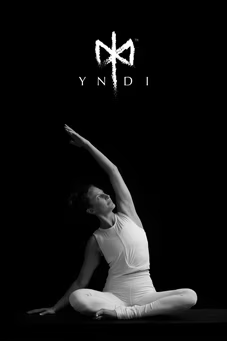


Support for PBS provided by:
Funding for ANTIQUES ROADSHOW is provided by Ancestry and American Cruise Lines. Additional funding is provided by public television viewers.


